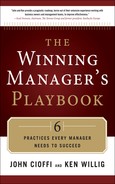So, what do we actually do?
The reality is that most of us set goals and create strategies in an iterative process. We go back and forth to test the reasonableness of each.
For example, most of us always have some knowledge of our marketplace and our capabilities. In effect, we have some version of the Spider Diagram, however imperfect, in our mind.
Thus, based upon the available information, we create, in our minds, some rough but credible strategies that allow us to set a reasonable range for our goals. Then we set the specific goals, within this range. Finally, we create the detailed strategies we’ll use to achieve the goals.
For example, in the case of our mall-based sandwich shop, we might know that there are five other lunch places in the mall, that we only have seating for 25 people at a time, that the average price per lunch is $7.50, and that we can turn the tables approximately three times each lunch period. Based upon this information, we might set a revenue or profit goal for the shop, and then create the detailed strategies.
All the while, we might convince ourselves that we set goals and then created strategies. But it was only after we had enough knowledge of our available strategies that we were able to set the goals—in effect, to get ourselves in the ball park of reasonable but challenging goals.
So why does this even matter? Why do we care whether strategies or goals come first?
The answer is that the planning process makes logical sense only if we create strategies first. Even if they are rough or imperfect strategies, we then use them to create a range within which goals are reasonable and challenging. Then, we set the specific goals. Finally, we create the detailed and more perfected strategies to attain those goals.
Thinking this way about the planning process is especially useful to your team. When they are observing your marketplace, assessing your internal capabilities, or exploring new opportunities, you want them to be using that information to formulate possible strategies for success. You want them to be thinking about what the organization will actually do in light of the changes that have occurred. You want them to be thinking strategically—all the time.
The current “great recession” is a case in point. Before the recession, many businesses were growing in size and profitability each year, with blue skies overhead. When the recession took hold, goals that might previously have been attained were no longer reasonable. This is because the previously-available strategies were no longer available (for example, charge premium prices, sell only high-end goods), and because new strategies were often focused on survival (for example, create incentives just to get people to come into the store).
In effect, neither the old or the new strategies allowed most businesses to keep their previous goals in range. As a consequence, these businesses had to “change their expectations” under the current economic conditions.
The ability to set goals, then, is limited by the strategies that you can create. These in turn are determined by the capabilities of your organization and the external environment—those four major information categories described previously.
If this wasn’t the case, you’d simply set the goals at astronomical levels, believing that somehow there existed a strategy to reach them. Pretty soon, you could become the Gross Domestic Product of the entire country, all by yourself.
